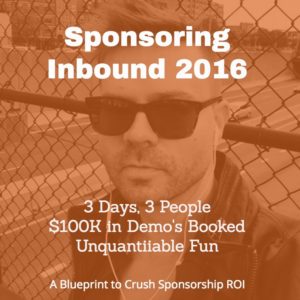
We’ve all gotten that email, shit we’ve all sent that email, yup, I’ve definitely sent that email. You know…..“Hi Name, I’m just following up.” It’s a perfectly logical thing to say, because you’re well… “Just following up.” What is the origin of this email? I’m guessing it dates back to the early 90’s when email communication really started to ramp up in the sales world. At least if it was born in the 90’s, I can picture an account exec in hammer pants, a no fear t-shirt and killer fanny pack hitting send on that “just following up” email thinking it was just pure gold baby!. Maybe “just following up” was conceived simply because the nature of the email is called a “follow up email” and everyone took it to literally.
Writing super bangin’ email copy has become more important than ever in sales. That is bad news for many organizations who don’t treat pre-opportunity and pipeline email copy as a competitive advantage. Cold calling is not dead in SaaS, I’m really sick of that article that resurfaces every few weeks on Linkedin. But it is hard to get a hold of prospects on the phone these days with the dial by name directory’s almost every company is starting to implement, especially small to mid market SaaS and tech company’s. With the rise of intelligent outbound prospecting tools like Datanyze & Clearbit paired with outbound sales email tools like Persist IQ, Salesloft and Outreach you can more easily identify and message cold prospects than I ever could’ve imagined even 2 years ago.
Great email copy should be a proprietary advantage over your competitors during all touch points in the sales cycle. Think about it, how many emails happen during the lifecycle of a deal with a ACV of even say $5K? How about $25K? The higher the ACV, typically the more touch points with more contacts within an account. We’re talking minimally 10-20 email touch points and I’ve closed deals at $30K -$40K that required well over 40 prospect facing emails (not including your internal emails about advancing the deal to the dev, support, c, or marketing team). Now think about this…….what if you beat the competing account executive in every one of those emails? I’ve personally beat and have helped my team beat competitors in head to head battles, I truly believe email copy played a pivotal role in those wins. Every word mattered, words matter, I believe that, do you?
Entirely controlling the buyer timeline isn’t possible. It is however absolutely possible to control as much of the time line as possible with world class email copy and follow up tactics. It drives getting real answers, holds prospects accountable and ultimately, it’s your job to manage and push the boundaries of the buyer journey timeline. If you ever lose a deal for holding a prospect accountable to a timeline and expressing extreme confidence that your solution will have a significant impact. That prospect was likely a pretender. You’ll win more business than you lose over the month, quarter or year I promise you (when executed well).
Typically, the context of the “Just following up,” email is the prospect hasn’t executed the next action you naively believed was going to happen exactly as it played out in your mind. That delinquent next action could be many things…..
- the prospect hasn’t responded to a request for a next step
- the prospect didn’t show up to the demo or discovery call
- the prospect didn’t show up to the post demo next steps call
- or even worse than the above, you didn’t have them accept an invite for a next steps call on the prior call (critical mistake) and now your in early deal purgatory
- the prospect has failed to answer a critical question, stalling your next step
- the prospect has missed an agreed upon deadline
- the prospect hasn’t produced key deliverables to you
- the prospect hasn’t given you an update on their internal conversations around the solution or pricing / budget
- the prospect hasn’t executed the panda doc contract (@jaredfuller?)
- the prospect hasn’t made payment against terms (gulp)
There are many unique follow up scenarios that require ninja like linguistics, politicking, psychological hannibal lectering and situational analysis. BTW, who wins super bowls???Teams that excel at situational football, teams that execute in the moment and have practiced this scenario and prepared for it . I’m going to go there and say each “follow up” scenario truly is a snowflake and should be treated as such. Let’s go a level deeper into why “just following up” isn’t effective…
Why “Just Following Up” Isn’t Effective
- it doesn’t induce any real action, it’s a free pass for prospects to ignore you
- general questions get one of two things from a prospect (1) crickets or (2) general answers that leave you even more in the hole
- you’re not basing follow up on the useful data (hopefully) collected during the sales journey, huge mistake
- when your prospect knows via your questions and statements you’ve been listening and are clearly on point. It’s much harder for them to go crickets
- any sales person in the world can write “just following up”, literally. Be better than that, stand out in a sales journey. People buy from people, don’t be a snooze fest, be a fun and challenging fest!
- you aren’t holding the prospect accountable to the historically communicated next step and hence the timeline
- you aren’t getting to the “why” of the stalled deal communication
- you aren’t placing any true urgency
- you aren’t providing a strong pivot point for deal communication
- you can’t explain to your sales leader why this deal is stuck, that is never good in a pipeline meeting (definitely not good in my pipeline meetings)
- it shows you can’t advance deals at a high level, good luck getting that Sr. Account Exec or other promotion…
I love follow up emails, I like to be bold with them, I still love the thrill of the hunt even in a routine follow up. I want the prospect to know they aren’t executing the timeline and next steps we’ve agreed upon together. I want them to know that if the timeline has changed, that is 100% okay , but I’m going to need a real answer as to why. I want them to know I’ve been listening to everything they’ve been saying about the timeline, but their actions say otherwise. Direct, specific, action inducing, hard to ignore follow up is what I am talking about. There are all stages of follow up across the sales cycle from getting that first discovery call booked, all the way to getting that Panda Doc signed and payment submitted right @JaredFuller 😉 ?
The art in a sexy follow up email born between the realms of assertive yet accommodating. It’s showing you’re a formidable adversary when you need to be, you listen to the critical info, while empathetic at the same time. It’s a mind set, let’s get you in that mind set. You can easily argue that when a prospect reads your follow up email, they should feel bested but certainly not bitter. Step one is to reframe how you think about follow up emails. They’re a weapon, they can separate you from the competition, they can be the difference maker, let them be!
Think About High Performing Follow Up Emails Like This Instead
- The timeline you’re pushing is what you and the prospect agreed upon, so what’s changed? Why shouldn’t they be held accountable?
- Every day they aren’t solving the prescribed pain with your medicine, they’re either losing money, time, efficiency, market share, leads, customers, data, or whatever the cost is. It’s real, if you’ve done your job, you can quantify it and keep it front and center during the entire sales cycle, especially during the “crickets” cycle!
- Pushing a timeline with some polished ferocity helps you identify pretenders pretty quick, it’s a great de-qualification tactic. Which means can go “on to the next one” just like the Jiga Man says
- It keeps your oppty pipeline lean and mean, less “I haven’t heard back” conversations with the old boss-a-rooney, god knows we don’t want to hear those words
- It gives you confidence in your % likely to close reporting, that your boss will love, especially when those deals actually close – it shows your instincts and projections are spot on
- No real buyer will ever give you the Heisman for asking concise follow up questions based upon information they provided to you
- Getting real answers allows you to pivot follow up for real buyers and get more in alignment with the realistic timeline
- The timeline a prospect quotes you during that first demo is almost never the real timeline, it’s always naively optimistic
- Things happen, it’s okay, priorities shift for people every day, but don’t be blind to the why or you have no funnel optics
- If you’re writing a follow up email, they likely didn’t respond to your last email, you need answers, fast or the trail gets colder and colder…
Keys to Highly Converting & Action Inducing Follow Up Emails
- ask short direct questions that result in short direct answers
- have an empathetic tone when it makes sense, nobody likes an a-hole
- leverage key prospect provided data that puts it on them
- keep it short, 100 words or less
- don’t use the word assume, it comes off as pompous AF in email, us the word “anticipate” instead, much more thoughtful
- send it to yourself, pull it up on your phone – what was your first reaction?
- remind them a status update takes all of 30 seconds to fire off
- give the sentiment of “We” when you can, it promotes togetherness while still getting to the heart of the issue
- when requesting a next connection point, give a specific time or date, ask for forgiveness later. it can better to send the invite and work the details out later, use your gut on this
- get to the point first, finish with pleasantries during sign off
- maybe most importantly, always schedule a next step and ask the prospect to accept the invite
Okay we’re pushing 2,000 words so I’ll get to the sexy sexy. Here are some suggested alternatives to the “I’m just following up,” themed email. As a disclaimer, different messages are clearly for different stages of the deal cycle.
“Just Following Up” Email Copy For Real Answers
- Is {Company Name} moving forward with {solution}?
- Today can you update me on where {company} is at with a yes or no to move forward with {Solution}?
- During our product demonstration, we identified implementing {X} solution in Q(1/2/3) was a priority. I want to support you in executing against that, so I’m sending over a calendar invite for {Day, Time} to get us back on track. If that doesn’t work, please provide 2 times that work for you this week
- I anticipate the original timeline we collaborated on was optimistic (it happens). Likely 1 of 3 things happened. (1) Your still interested, but priorities shifted (2) The original timeline of {X} weeks is changing to {Y} weeks (3) You’ve ruled {solution} out as an option for {Company Name}. No answer is the wrong answer, which is it?
- Is {Company’s} goal is to have {solution} implemented by {date}? That is exactly {x} weeks from today, successful on-boarding for similar use cases does require {y} weeks to ramp. If we don’t cross finish line together today, we’ll likely fall short of that goal. Can we get this done by end of day today?
- I only push next steps when I know with 100% certainty {solution} can have a significant impact on {y objectives}. You’ve shared with me that {share}, every day/week we wait is likey costing you {X Units} of {Measurement}. Can you talk tomorrow at 3pm?
- We haven’t collaborated since I provided the critical answers to the questions you requested for {Company} to further evaluate {solution}. Did the answers I provided create hesitation within your team about taking a next step?
- Have you talked with {co-worker name} yet? That was your identified next step, I can start an email thread with the 3 of us this afternoon to kick things off. Can you please provide her email please so we can collaborate?
- Today can you find 30 seconds to hit me with the reality on where we’re at? I can guide the appropriate next step and get re-aligned with your timeline from there.
- What was your boss’s feedback on pricing? I know owning this investment puts pressure on you, I can invite for a value vs. price demo between the 3 of us.
- It seems we’ve stalled, I’m placing an invite on your calendar for 2pm Thursday, talk to you then, look forward to getting back on track together
- I’m anticipating you likely ruled out a Q2 implementation as we’re 30 days out, is the first 30 days of Q3 the new timeline?
The goal here isn’t for me to write every single follow up email for every deal stage situation, although that would be a killer chronicle to write. Rather, I hope you take pause and think about hitting send on that next email. What is the account exec on the other end of this deal writing right now? Is this my best work? Am I getting real answers? Am I holding my prospect accountable? Is my solution truly right for them? Am I asking the right questions? What answers to what questions would give me the advantage in winning this deal today?
I don’t like to force action, I like to educate and let smart people make the best decision they can. There is an animal inside all of us, dig deeper, reach within, push your comfort zone and always……“Recognize, Feed & Grow the Animal Within.”
Kyle Hale

